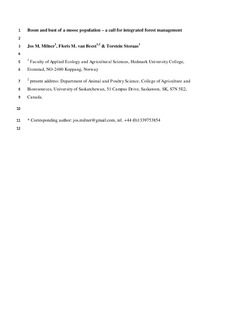Boom and bust of a moose population – a call for integrated forest management
Journal article, Peer reviewed
Permanent lenke
http://hdl.handle.net/11250/134464Utgivelsesdato
2013Metadata
Vis full innførselSamlinger
Originalversjon
Milner, J. M., van Beest, F., & Storaas, T. (2013). Boom and bust of a moose population: a call for integrated forest management. European Journal of Forest Research. doi: http://dx.doi.org10.1007/s10342-013-0727-9 10.1007/s10342-013-0727-9Sammendrag
There is increasing pressure to manage forests
for multiple objectives, including ecosystem services and
biodiversity, alongside timber production. However, few
forests are currently co-managed for timber and wildlife,
despite potential economic and conservation benefits. We
present empirical data from a commercial Norway spruce
(
Picea abies
) and Scots pine (
Pinus sylvestris
) production
system in southern Norway in which moose (
Alces alces
)
are an important secondary product. Combining long-term
hunting and forestry records, we identified temporal vari-
ation in clear-felling over the past five decades, peaking in
the 1970s. Herbicide treatment of regenerating stands and a
fivefold increase in moose harvest has lead to a reduction in
availability of successional forest per moose of
[
90 %
since the 1960s. Field estimates showed that spraying with
the herbicide glyphosate reduced forage availability by 60
and 96 % in summer and winter, respectively, 4 years after
treatment. It also reduced moose use and habitat selection
of young spruce stands compared with unsprayed stands.
Together these lines of evidence suggest that forest man-
agement led to an increase in moose carrying capacity
during the 1970s and a subsequent decline thereafter. This
is likely to have contributed to observed reductions in moose population productivity in southern Norway and is
counter to sustainable resource management. We therefore
call for better integration and long-term planning between
forestry and wildlife management to minimise forest
damage and the development of large fluctuations in
ungulate populations.
Beskrivelse
This is the postprint version of the article. The published article can be located at www.springerlink.com
